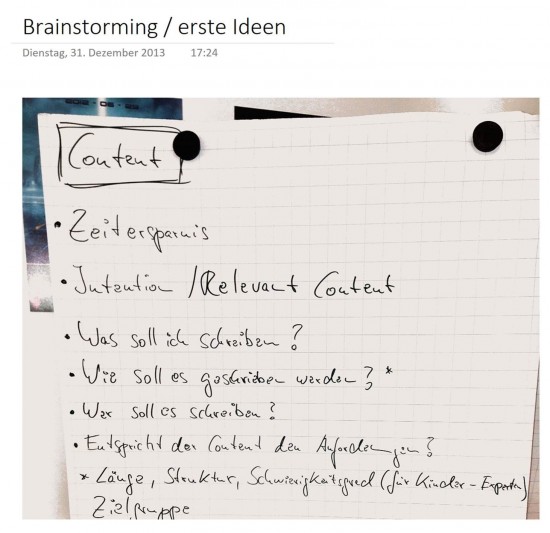What’s one of the biggest challenges facing online companies today? Many struggle to create content that is relevant for both the user and for search engine results! Because content production is one area where a data-driven approach remains rare, much depends on guesswork and intuition.
For years, we’ve been stuck with the status quo: Microsoft Word remains a scratchpad for both research and writing. Authors demand creative freedom, and online marketers struggle to gauge results until well after they publish.
Today, production of online content is set to change tremendously – towards agile, data-driven content development, supported by deep learning technology.
Take the processes of administration, accounting, procurement and evaluation. In today’s online world, almost every step is automated or extensively tracked. KPIs are measured, data is analyzed – and this information forms the basis for decisions regarding subsequent processes. Yet, little has been done to plug the gaping hole in the area of content.
We at Searchmetrics aim to be trailblazers taking the first giant leap into:
The era of data-driven, agile content development.
We call it “The Searchmetrics Content Experience”
 Years ago, we set ourselves the goal of eliminating the bits and pieces, the work-arounds, the guesswork and the data gaps – and ultimately of making life much easier for everyone involved in the content process.
Years ago, we set ourselves the goal of eliminating the bits and pieces, the work-arounds, the guesswork and the data gaps – and ultimately of making life much easier for everyone involved in the content process.
But let us start at the beginning, with our motivation and why we believe what we are doing is important – and why it is set to revolutionize how content is created.
Problem 1: Content development is rarely data-driven
In terms of how online content is produced, we’ve been stuck in the Dark Ages. As a rule, the development of online content begins following keyword research or the application of keyword tools to conduct a manual analysis of the current state of existing pages.
People proudly research thousands of keywords, and then spend days building pivot tables in Excel, which laboriously sort the keywords topic for topic. Without criticizing this challenging and complex work, in my honest opinion, it is not particularly effective.
Problem 2: Gaps in the information flow between stakeholders
Editors (ideally working in-house, but oftentimes external) are then tasked with using the table to write a specified number of words on the topic, making sure that they include a certain list of keywords. (Can we really call this an “editorial brief”?) This is done in the hope that the new or updated pages will be holistic, rank well with Google and convince the user.
Content, however, is approved by a third person. The publication and performance-tracking of the content is, in the worst possible case, carried out by a fourth and fifth person. And most of these people have different skills and different knowledge, they work with different KPIs and they report to different superiors.
More than three years ago, we at Searchmetrics came to the realization that 1) the days of keyword optimization are over, 2) communication and information processes should be as gap-free as possible and 3) the creation of relevant content, which complies with both user interest and search engine criteria, should have the highest priority for online businesses.
We decided to do something about it.
The solution: Enabling content collaboration based on big data
Since our epiphany, we have been working on a solution with almost our entire team, with online marketers, content strategists and SEOs, all helping to:
- define the user interests of the target group(s),
- define thematic requirements,
- create content accordingly and
- ensure the measurability of success.
Above all, we are aiming to close the gaps in communication and information between all members of the content process – that is, those people who are working on the content strategy and those who are ultimately required to create the content.
Finding no market solution with which to test our theories, we had to tackle the huge challenge of building from scratch.
It is basically like wanting to build a house
The most important people involved are:
- the person whose house it will be, who has concrete ideas of what they do and don’t want
- the architect, who turns these wishes into a functional blueprint and
- the different builders and workers, who build the house
However, between you and me and anyone who has been involved in building a house: was it built exactly as planned? Probably not.
The result: A time-saving creative workflow!
The challenge we faced was developing something that improved workflows between all parties and, in some cases, made it possible for them to work together for the first time.
Because it is creative people who drive content creation, the process should be a highly visual and straightforward one, putting an end to processes like the time-consuming development of pivot tables, giving instructions (“briefs”) of soul-destroying length to content writers and finally, as a last step, dealing with unwieldy analytics solutions in order to gain some kind of approximate idea of how the content has performed.
Dealing with setbacks and tackling problems are the foundation for success!
We developed the first ideas and prototypes three years ago, when we were highly optimistic of making quick progress. However, in intense discussions with the individual parties, we quickly realized how different each party’s motivation is.
Solutions, working methods and even the definition of success were thus:
- SEOs look for things like traffic and visibility,
- managers are more interested in conversions and ROI, and
- content writers focus on the content itself, the user and the story they are telling.
The best of four prototypes – in permanent dialogue with our customers
This meant we didn’t just build one prototype – over the last more than three years, we built four different ones! We launched pilot projects that let different clients test the entire workflow. We conducted over a hundred hours of in-depth interviews and we repeatedly questioned or discarded what we had, going back to the drawing board.
One of the most important points was designing the user interface so that it was a simple as possible. This is why we included gamification elements and tested how people would react to them on an emotional level. At the start, we had thought it would be a piece of cake. WRONG!
You think Route 66 is long? You should see our roadmap!
To begin with, we wanted to be ready for dmexco 2014. That didn’t quite work. So we expanded the team to around 20 people and then we wanted to be ready for dmexco 2015. That didn’t work either.
Why not? We didn’t want to launch something that just looked good, but which didn’t actually improve the workflow and deliver genuine value. Our guiding principle was ensuring we were always solving the problems at hand, even if adhering to this principle required an extremely large amount of work and was, at times, frustrating.
A strong team delivering strong software!
But we kept going. In early 2015, we decided to expand the team again, significantly.
If you consider developers, product managers, data scientists and IT, then there are around 80 people working on the project. More work has gone into this project than with any other in-house development in the history of Searchmetrics. We had to invent an unbelievable amount because the algorithms and workflows we needed simply did not exist. It was worth it. The first reactions we’ve had from users have been breathtaking in their praise.
The following video gives you a nice impression of the software:
Agile content development
What we understood from the start was the development of content requires far more data than are currently used. Because if you don’t consider: 1. what the user actually wants, 2. what the competition is doing, 3. the seasonal changes around the topic, then you don’t have the foundation for any kind of success.
With the Searchmetrics Content Experience, we now have created the solution for successful content development.
Find out more about the Searchmetrics Content Experience
At the heart of the software, we have deep learning technology, machine learning and developments in the field of natural language processing. This solution gives online marketers and SEOs the possibility of creating content that is exactly targeted to the user’s interests, and which provides all the data needed to be genuinely relevant.
This lends predictability to the success of online content – even before it is published!
We refer to the process of developing successful content according to specific goals as “agile content development.” The parallels to the agile development of software are easily apparent. That is another area where several people work on products or features. And modern software development is agile, transparent, honest and collaborative. We want to achieve the same when developing user-centered content.
The building blocks of agile content development
Research
The development of successful content begins with research. For this task, Searchmetrics has developed the Topic Explorer, which lets users intuitively understand topics and user intention. The automatic calculation of the competitive environment makes it quickly apparent which content is missing and which topics are rich in potential. This saves hours working with Excel tables or relying on gut feeling to define topics. The Topic Explorer automates this process and, while doing so, it considers hundreds of millions of existing keywords. Pivot tables that have to be painstakingly built from scratch become a thing of the past when it comes to identifying topics that go together or which correspond to the same user intention.
Once you have seen and tried out the Topic Explorer, you won’t want to go back to your Excel tables. By clicking on a topic, the results of the research can be used directly to create editorial briefs.
Here two examples from the Topic Explorer.
“Fluoride in water”
“Fashion”

Optimization
During optimization, writers can use our content editor to create the content requested by the interactive brief. All the time, they are given help and support by our deep and machine learning technologies, in the form of interactive parameters such as a live content score.
Performance-tracking
Performance-tracking makes it possible to use indicators to continuously measure and monitor the success of the content strategy. This is where the connection to the SEO Suite comes into its own. Because we integrate not only SEO KPIs such as Visibility, but also analytics, success can be seen directly in the form of traffic and conversions. This provides a 360-degree view of whether the content is performing well or whether existing content is performing better than before.
SEO and content: Hand in hand with the Searchmetrics Suite products
Everything that has been described here is automatically connected to the SEO Suite, which can be used to directly manage and monitor topics, keywords and successes, as well as to differentiate between classical SEO projects and content.
This means that existing SEO Suite customers do not have to duplicate projects they are creating or working on. Our goal is the creation of a complete A-Z workflow, which makes barrier-free, user-friendly and unbelievably time-saving collaboration possible within our software platform.
What is deep learning?
For the Searchmetrics Content Experience, we do not rely on data from third parties. One of the primary foundations is the Searchmetrics Research Cloud database, with which we parse 250 billion continuously updated data points, the largest index in the industry.
This index is supplemented by vast quantities of further data, which our crawlers gather every day – and which is incorporated into custom-developed algorithms within the Searchmetrics Content Experience. This is, it must be emphasized, data that is fully up-to-date.
Using data science to train language-dependent models
Data science is very important to processing this data. Deep learning models, which develop independently, and natural language processing, both have an enormous role to play.
Furthermore, the software does not just work for any and every language because the models first have to be painstakingly trained, a process that can take between several months and a year. We currently support German and English, with French coming soon. The data basis, the models and the continual self-improvement of the algorithms combine to make the Searchmetrics Content Experience a tool for agile content development.
For our field of content creation, this means that researching topics, competitors or content requirements all takes place in the background. This lets online marketers and SEOs concentrate fully on strategic aspects of content, the editorial brief and performance tracking. At the same time, the writer receives all necessary information and ongoing support throughout the process of content creation.
Premiere at dmexco and Content Marketing World
In September 2016, Searchmetrics unveiled the Content Experience to the public for the first time. The world premiere took place at Content Marketing World in Cleveland from 6th to 9th September.
A week later saw the European premiere of the Searchmetrics Content Experience at dmexco 2016 on the 14th and 15th September 2016 in Cologne – both eents saw great public enthusiasm for the product. Many of the 50,000 visitors at the Europe’s biggest online marketing fair stopped by at Searchmetrics’ 65m2 stand.
The feedback we received at both fairs was overwhelmingly positive.
Step by step into the future: With our customers
Before we presented our software to the public for the first time, several Searchmetrics customers spent months testing the Searchmetrics Content Experience in order to further improve the product. One expert to have tried out the software is Joe Pulizzi, Founder of the Content Marketing Institute.
Curious? Get a Searchmetrics Content Experience Trial!
We firmly believe that the creation of content should be significantly more data-driven than is currently the case. But the Searchmetrics Content Experience is not software for which you can just send the login information to everyone involved and hope that they will start using it. The reality is that the attachment to existing, ingrained processes is much stronger than you might think. For this reason, when releasing the software, we are ensuring that we work closely with our customers and other interested parties to look at their content creation processes. This helps us present the software in a targeted way that matches each customer’s specific needs. There is one thing I have learnt the hard way: If you ask 10 companies how they create content, then you get at least 11 different answers.
More information about the Searchmetrics Content Experience, including the opportunity to request a trial version, can be found here:
Find out more about the Content Experience Suite
Welcome to a new era of online content!








